Sviatohirsk
Svjatohírs’k (Ukrainian: Святогі́рськ) or Svyatogorsk (Russian: Святого́рск) is a town in Donetsk Oblast, Ukraine. A part of the Sloviansk Municipality, it stands on the banks of the Seversky Donets River, 30 kilometers (19 mi) from the city of Sloviansk. Population: 4,654 (2013 est.);[1] 5,136 (2001 est.).
Sviatohirsk Святогірськ Святого́рск • Svyatogorsk | |
|---|---|
City | |
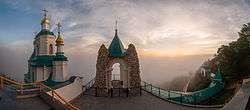 View of the St. Nicholas Church and the St. Andrew Chapel of the Holy Mountains Lavra | |
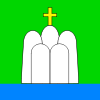 Flag .png) Seal | |
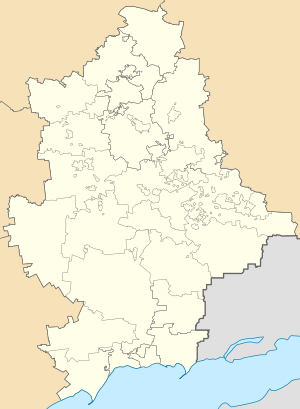 Sviatohirsk Location of Sviatohirsk within Donetsk Oblast  Sviatohirsk Location of Sviatohirsk within Ukraine | |
| Coordinates: 49°02′N 37°34′E | |
| Country | |
| Oblast | |
| First mentioned | 16th century |
| Population (2013) | |
| • Total | 4,654 |
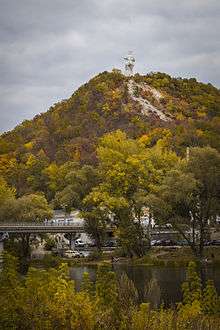
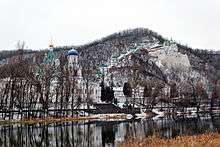
History
A settlement in the area of the Holy Mountains was first mentioned in written sources in the 16th century.[2] In 1624, a monastery was established here, but in the end of the 18th century all monastic lands were secularized and passed on to private owners.[2] One of the new owners built a bathing house on the nearby lake, which led to the settlement being called Banne (Ukrainian: Банне)/Bannoye (Russian: Банное) or Bannovskoye (Банновское); literally bathing.[2] Proximity of a nearby selo of Tatyanovka lead to the both places sometimes being collectively referred as Bannoye-Tatyanovka (Банное-Татьяновка).[2]
During the Soviet times, the selo was officially known as Bannoye.[2] In 1938, it was granted urban-type settlement status and renamed Bannovsky (Банновский).[2] The settlement served as a resort destination and steadily grew in size, until in 1964 it was granted town status and renamed Slovianohirsk (Ukrainian: Слов'яногірськ)/Slavyanogorsk (Славяного́рск), with the first part of the name (Sloviano-/Slavyano-) being after the nearby city of Sloviansk (Slavyansk), and the second part (-hirsk/-gorsk) being after the Holy Mountains.[2] In 2003, the name was changed to Sviatohirsk, after the monastery itself.[3]
Unlike neighboring Sloviansk, Sviatohirsk was never controlled by the pro-Russian forces who in spring 2014 had made Sloviansk their stronghold.[4]
Culture
Sviatohirsk includes the Holy Dormition Sviatohirsk Lavra, the Holy Mountains National Park, an historical and architectural reserve, as well as a resort of national importance; thirty objects, among them a monumental sculpture of Communist leader Artem (Fyodor Sergeyev) and a World War II memorial (opened on the day of 40th anniversary of victory) are included in the historic monuments complex of the reserve. The town has been visited by well-known cultural figures, including Hryhorii Skovoroda, Fyodor Tyutchev, Ivan Bunin, Anton Chekhov, Maxim Gorky, Marina Tsvetaeva, and Ilya Repin.
On May 15, 2015, President of Ukraine Petro Poroshenko signed a bill into law that started a six months period for the removal of communist monuments and the mandatory renaming of settlements with a name related to Communism.[5][6][7] However, since the Artem monument is listed as "National Cultural Heritage" it will not be demolished.[8]
Tourism
The development plan of Sviatohirsk provides a significant expansion of the resorts, recreational, and tourism network. Within the Sviatohirsk resort are the Holy Mountain sanatorium and hotel-and-tourist complexes. The town carries out a construction and modernization of recreation departments for children and adults.
Early in 2009, a four-star hotel opened. Sviatohirsk also offers the Seversky Donets River, chalk mountains, coniferous and mixed forests, centuries-old oak trees, and clean air.
References
Notes
- Чисельність наявного населення України [Actual population of Ukraine] (in Ukrainian). State Statistics Service of Ukraine. Retrieved January 21, 2015.
- Pospelov [1], p. 31
- Pospelov [2], p. 387
- Ukraine Declares One-Week Cease-Fire in Fight With Pro-Russia Rebels, The Wall Street Journal (June 20, 2014)
- Poroshenko signed the laws about decomunization. Ukrayinska Pravda. May 15, 2015
- Poroshenko signs laws on denouncing Communist, Nazi regimes, Interfax-Ukraine.
- Goodbye, Lenin: Ukraine moves to ban communist symbols, BBC News (April 14, 2015)
- (in Russian) Zhebrovsky confirmed that Artyom monument in Svyatogorsk will not be demolished, depo.ua (29 December 2015)
Sources
- [1] Е. М. Поспелов (Ye.M. Pospelov). "Имена городов: вчера и сегодня (1917–1992). Топонимический словарь." (City Names: Yesterday and Today (1917–1992). Toponymic Dictionary.) Москва, "Русские словари", 1993.
- [2] Е. М. Поспелов (Ye.M. Pospelov). "Географические названия мира" (Geographic Names of the World). Москва, 1998.
External links
- Official web site of Sviatohirsk (in Russian)